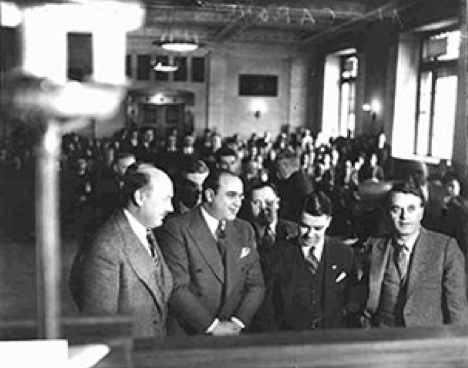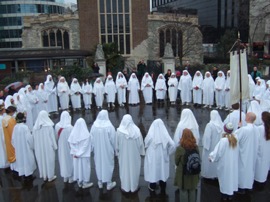About a month after the St. Valentine’s Day Massacre, which occurred in February of 1929, Al Capone and his lawyers were brought into George E. Q. Johnson’s office, the U.S. District Attorney assigned to Al Capone’s case, for questioning for the murder of six men who were allegedly a part of George “Bugs” Moran’s gang. Later in the day, long after Capone had left, an explosion occurred in the same room where Capone had been questioned. Johnson rushed into the room in total shock, knowing that he had been only a few rooms away from sudden death, and could have been yet another of Al Capone’s victims.1
Shortly after the Massacre, President Herbert Hoover was inaugurated President, and one of his first lines of action was to make sure Al Capone went to prison.2 He wanted to send the message that such “brazen criminology would no longer be allowed.”3 As a result, he appointed the top officials of every relevant agency, most importantly the Department of Treasury, to the case since their main focus was to get Al Capone for tax evasion. The Justice Department too was told to gather a group of agents, led by Eliot Ness, to get the crime in Chicago under control, especially the problem of bootlegging alcohol. Initially, Ness was having a lot of trouble, but as his approach became more aggressive, Al Capone became concerned. Capone attempted to bribe Ness and his men, hoping that they would stop disrupting his bootlegging business. Ness was not tempted by Capone’s gracious bribe, and because of that, he and his team were subsequently referred as “The Untouchables.”4

Although Al Capone was being watched and tracked by the government, his bootlegging business continued. Ness raided Al Capone’s brothers’ headquarters, Ralph Capone, and wire-tapped all of his telephones, hoping to receive information about where all of the breweries were. From that point on, the Untouchables destroyed more than $1 million worth of alcohol and equipment. Although they were able to gather much information about speakeasies, none of that information was used in court, unfortunately. Ness’ work was not a waste of time, however, due to his ability to track down many of Capone’s breweries and shut them down.
Another important group interested in bringing Capone to justice is a group called The Secret Six. This group was organized by Robert Randolph, president of the Chicago Association of Commerce. He solicited money from Chicago’s elite, who were afraid of Capone as well, to have the necessary funds to take Capone down. The Secret Six was in agreement with the government to not get involved with Al Capone’s specific crimes, but to help police enforce the law in Chicago. Since most of the crimes in Chicago were related to gang violence and Prohibition, they were able to reduce homicide rates related to these crimes. The Secret Six didn’t specifically participate in Al Capone’s trial, but they were able to save it and helped determine the outcome. They had the responsibility to protect key witnesses, such as Leslie Shumway and Fred Ries, for future trial dates.5
The U.S. Government was working hard to convict Al Capone, and as a result, Capone and his lawyers met with Johnson to discuss a plea bargain. On June 16, 1931, Capone agreed to plead guilty for tax evasion in return for a two-and-a-half year sentence. However, Judge Wilkerson did not approve the deal and denied the bargain on June 30. Capone then withdrew his guilty plea to take his chances with a trial.6 Several witnesses were brought to the stand in October of 1931, including Leslie Shumway, who provided a general ledger containing daily financial reports of liquor sales. Charles Arndt, Chief of Chicago’s Bureau of Internal Revenue, also testified that there was no record of Alphonso Capone paying his income tax. Lastly, Fred Reid testified that Capone was making huge profits, and that those profits were not recorded in any income statement. He said that they were wasted on gambling on horse racing and dog racing.7 According to data collected by the Department of Treasury, between the years 1924 and 1929, Al Capone had made roughly $1 million, and he therefore owed taxes amounting to roughly $215,000.8

During the trial, District Attorney Johnson showed the jury that Capone was successful, and that all the money from his businesses was going to him. Al Capone had extravagant spending habits, but all the money that he spent failed to appear on his income statement. He had expenses, such as fine food, expensive clothing, and a beautiful mansion in Palm Beach Florida. But how was Capone making all of this money? Johnson was able to show through evidence that his casinos and his speakeasies in Chicago were making large amounts of money. To make it inconspicuous, the profits earned were transferred to bank accounts in Miami, where Capone’s associates would pick them up for him.9
On October 11, Michael Ahern and Albert Fink, Al Capone’s lawyers, countered Johnson’s arguments. Ahern claimed that the government wasn’t coming at Al Capone because he wouldn’t pay his taxes. Rather, it was a surreptitious way to put him in jail for all the crimes that were allegedly connected to him. The government was trying to prove that Capone was making an abundance of money, and he failed to pay his taxes. Ahern claimed that his luxurious spending habits had no correlation in the context of the case.10
Many of the other key witnesses had yet to be called to the stand by Johnson, and Al Capone and his lawyers were anticipating that the feds were to put up as many as they could. However, as Johnson approached Judge Wilkerson, he said “Your honor, the government now rests,” leaving Al Capone and Ahern in shock. Ahern and Fink had intended for witnesses from all over to testify on Capone’s behalf, giving evidence of Capone and all of his massive losses due to gambling.11 The major premise of their case was to show that losses in gambling was not taxable; therefore, failure to pay taxes was just a mistake on account of it. They also tried to make the point known that there was no political reasoning behind this case, and that this was just an attempt to pin Capone for the failure to enforce Prohibition laws. Due to the suddenness of Johnson’s rest, Ahern and Fink were not prepared to call their first witnesses; they therefore requested a two-day delay. When Wilkerson denied their request, Ahern asked the judge for ten hours in front of the jury to present their defense, but the judge only granted them four.12

On October 15, 1931, court was in session again. Before the jury re-entered the court room, Ahern had a discussion with Wilkerson about permission to bring up certain points in the case. After Wilkerson denied his permission, Ahern angrily exclaimed that the Constitution was corrupt. He began to say to the jury that this case, again, was merely a way of blaming Capone for the lack of enforcement of Prohibition laws, saying that he was the cause of many gang related deaths. He ended by mentioning that Al Capone was forced to plead guilty for tax liability.
That night, Johnson contemplated what he would say the next morning. On October 16, Johnson began by giving the known fact that every American who exceeds an income of $1,500, must pay an income tax. He went for a simplistic approach by forgetting about all the other crimes that Al Capone had allegedly done in the past. It was simply a case of one man failing to pay his income tax. Johnson mocked Capone and compared him to a false Robin Hood.13 Johnson mentioned the time Capone bought $5,000 worth of diamond belt buckles, and $6,500 worth of meat. It didn’t go back to the poor though; it went to his lavish lifestyle in Florida.
It took the jury over eight hours to come to a verdict. On October 17, 1931 at 10:50 P.M., everyone was called back to court. Wilkerson took his position and asked, “Has the jury decided on the verdict?”14 They replied, “Yes your honor, we find the Defendant guilty on counts 1, 5, 9, 13, and 18, and not guilty on counts 2, 3, 4, 6, 7, 8, 10, 11, 12, 14, 15, 16, 17, 19, and 20.”15 Everyone in the courtroom stood in confusion, and Al Capone had a smirk.16 Capone was called back to court in the following week to receive his sentence. When the week had passed, the judge then repeated in court that Capone would serve five years for each felony, and would be charged $10,000 for each, and then another two years for each of the misdemeanors, with another charge of $10,000 each, in addition to the time that Al Capone had already spent in jail for contempt. Wilkerson subsequently lowered the sentence to eleven years and $50,000.
Finally, two years after the St. Valentine’s Day Massacre, George E. Q. Johnson had finally gotten what he had been working for.17 Unfortunately, he could not get him for all of the gang related violence that he had committed in the past, but he achieved not only his goal, but President Hoover’s as well. This could not have been done without the help from Eliot Ness, and all those who were able to gather information about Al Capone’s income history. This case would go down in history as one of the toughest cases in tax history.
- Dennis E. Hoffman, Scarface Al and the Crime Crusaders: Chicago’s private War against Capone (Chicago: Southern Illinois University Press, 1993), 158-163. ↵
- UXL Encyclopedia of World Biography, 2003, s.v. “Al Capone,” by Laura B. Tyle. ↵
- Dennis E. Hoffman, Scarface Al and the Crime Crusaders: Chicago’s private War against Capone (Chicago: Southern Illinois University Press, 1993), 25. ↵
- UXL Encyclopedia of World Biography, 2003, s.v. “Al Capone,” by Laura B. Tyle. ↵
- Dennis E. Hoffman, Scarface Al and the Crime Crusaders: Chicago’s private War against Capone (Chicago: Southern Illinois University Press, 1993), 296-299. ↵
- Fred D. Parsley, Al Capone: The biography of a self-made man (Freeport, New York: Books for libraries press, 1971), 4-6. ↵
- Dennis E. Hoffman, Scarface Al and the Crime Crusaders: Chicago’s private War against Capone (Chicago: Southern Illinois University Press, 1993), 314-316. ↵
- Encyclopedia of the Great Depression, 2004, s.v. “Al, Capone,” by Robert S. McElvaine. ↵
- Dennis E. Hoffman, Scarface Al and the Crime Crusaders: Chicago’s private War against Capone (Chicago: Southern Illinois University Press, 1993), 306-318. ↵
- Encyclopedia of the Great Depression, 2004, s.v. “Al, Capone,” by Robert S. McElvaine. ↵
- John Kobler, Capone: The Life and Times of Al Capone (New York: Da capo press, 2003), 1-10. ↵
- Jonathan Eig, Get Capone (Simon & Schuster, 2010), 240. ↵
- Jonathan Eig, Get Capone (Simon & Schuster, 2010), 248. ↵
- Jonathan Eig, Get Capone (Simon & Schuster, 2010), 257. ↵
- Jonathan Eig, Get Capone (Simon & Schuster, 2010), 257. ↵
- Jonathan Eig, Get Capone (Simon & Schuster, 2010), 251-258. ↵
- Jonathan Eig, Get Capone (Simon & Schuster, 2010), 297-300. ↵



54 comments
Mariah Cavanaugh
Who doesn’t enjoy a dramatic trial with everyone on the end of their seats? You did a great job compiling and presenting the information all while telling a fascinating story. You set the scene so well when the jury returns with a guilty verdict. I can imagine Capone’s smug smile, and I felt a bit of excitement when he received his sentencing
Janelle Larios
I heard of Al Capone how he was apart of organized crime, that he was bootlegging alcohol, but I didn’t know that he was charged with tax evasion and that that was what sent Al Capone to jail. i thought it was wild that after he was brought in for questioning, the office where he was questioned had blown up. It seems like he went to such extra measures to cover up whatever he did. Which is not surprising of like gang related activities or organized crime but it still came as a surprise when I read it. Very interesting article.
Taylor Rech
Reading about the proceedings of Al Capone’s trial was interesting to me because I had never heard much about him before. I have always thought that it is one of the most ridiculous things when people who commit serious crimes plea bargain. Plea bargains are the defendant saying that they are guilty to try and fool the court that they feel bad, so they cannot have to spend so much time in prison, but then we let them back into our society and they go back to their illegal ways. Additionally, I think Johnson’s tactic to surprisingly not call witnesses to the stand and then his approach to attempt to get Capone on a simple matter was a great plan that helped him win in the end.
Maxx Arizmendi
I have heard of Al Capone in the past, but I didn’t know that he was charged with tax evasion. Knowing that he was bootlegging alcohol and he was involved in gang related violence, I also didn’t know that he was living a lavish lifestyle by having a mansion in Florida. Capone is an interesting criminal, and this article did great going into detail about the crimes of Al Capone.
Avery Looney
I have heard lots of things about Al Capone, but tax evasion was not one of them. When you hear Al Capone you think of the notorious gangster who reigned in the 1920’s, not as someone who failed to pay their taxes.This article does a great job of explaining how Capone got put away and what exactly happened in the court room. It is crazy that Capone was able to commit as many crimes as he did and only had to pay fines and serve eleven years in prison.
Lorenzo Rivera
It is extremely interesting to be able to see and realize just how much the justice system has changed over the years in the United States of America. Al Capone was one hardened criminal, and the fact that he was sentenced only to eleven years in prison is a prime example of what exactly was wrong with the country during this era. We may never know the exact nature of every crime he committed, but one thing is for sure, if even half of the crimes he was accused of at the time were true, then he should have spent a lifetime in prison.
Sebastian Carnero
I didn’t know about the Secret Six, it is interesting how much they helped being behind the spotlight. Capone had lots of hands ready to hurt whoever he wanted and without the witnesses, it would have been really difficult to pull off that trial. Laws are a scary thing, they can be used on someone’s favor and change lots of outcomes. Even if the people know about his crimes, nothing is true if it is not declared true by law. It was a really interesting case how all this situation had the best outcome because of something as simple as tax evasion.
Caden Floyd
The most known gangster in history, Al Capone, arrested for skipping on his taxes? To think that he only went to prison for a couple felonies and misdemeanors is ludicrous. Not only did he gat away with all of his gangster related activities he essentially got away with numerous murders. His lawyers really had his back throughout the while case, which isn’t surprising due to the fact that he was a very dangerous man. With todays technology I don’t think he could have gotten away with half the stuff he was not proven guilty for. I had always known Al Capone was a notorious gangster, but this article is so in depth and really lets you know who he really was.
Megan Copeland
Growing up, I had always heard stories about Al Capone, the notorious gangster. What I find really interesting is how short of a sentence he got considering the amount of crimes he committed. To only be convicted of tax evasion is insane. If Al Capone would have committed these crimes in recent years, I believe he would have gotten a worse punishment and would have been convicted for more of his crimes.
Reagan Meuret
It is hard to believe they were never able to catch Capone for gang related incidents. It is good they were able to find a loophole to send him to jail however. From this article it is pretty clear that Capone was a twisted and evil man who killed a lot of people. I also found it pretty impressive of Ness and his men to not accept any of Al Capone’s bribes as I’m sure it was a substantial amount of money to turn down.